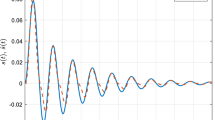Abstract
This paper proposes a new general recurrent state-space neuro-fuzzy model structure. Three topologies are under assessment, including the state-input recurrent neuro-fuzzy system, the series-parallel recurrent neuro-fuzzy system and the parallel recurrent neuro-fuzzy system. Moreover, the underlying generalised state-space Takagi–Sugeno system is proven to be a universal approximator, and some stability conditions derived for this system. The online training is carried out based on a constrained unscented Kalman filter, where weights, membership functions and consequents are recursively updated. Results from experiments on a benchmark MIMO system demonstrate the applicability and flexibility of the proposed system identification approach.









Similar content being viewed by others
References
Ariño C, Sala A, Pérez E, Bedate F, Querol A (2017) Asymptotically exact stabilisation for constrained discrete Takagi–Sugeno systems via set-invariance. Fuzzy Sets Syst 316:117–138 (theme: control engineering)
Bourahala F, Guelton K, Manamanni N, Khaber F (2016) Relaxed controller design conditions for Takagi–Sugeno systems with state time-varying delays. Int J Fuzzy Syst 1–11
Chang Y-C, Chen C-H, Zhu Z-C, Huang Y-W (2016a) Speed control of the surface-mounted permanent-magnet synchronous motor based on Takagi–Sugeno fuzzy models. IEEE Trans Power Electron 31(9):6504–6510
Chang P-C, Wu J-L, Lin J-J (2016b) A Takagi–Sugeno fuzzy model combined with a support vector regression for stock trading forecasting. Appl Soft Comput 38:831–842
Dash R, Dash PK (2016) Efficient stock price prediction using a self evolving recurrent neuro-fuzzy inference system optimized through a modified technique. Exp Syst Appl 52:75–90
Dunik J, Simandl M, Straka O (2012) Unscented Kalman filter: aspects and adaptive setting of scaling parameter. IEEE Trans Autom Control 57(9):2411–2416
Feng G (2006) A survey on analysis and design of model-based fuzzy control systems. IEEE Trans Fuzzy Syst 14(5):676–697
Feng Z, Zheng WX (2017) Improved stability condition for Takagi–Sugeno fuzzy systems with time-varying delay. IEEE Trans. Cybern. 47(3):661–670
Gao Q (2017) Universal fuzzy models and universal fuzzy controllers for stochastic non-affine nonlinear systems. In: Universal fuzzy controllers for non-affine nonlinear systems. Springer, Singapore, pp 45–70
Gao Q, Zeng X-J, Feng G, Wang Y, Qiu J (2012) T–S-fuzzy-model-based approximation and controller design for general nonlinear systems. IEEE Trans Syst Man Cybern B Cybern 42(4):1143–1154
Gao Q, Feng G, Dong D, Liu L (2015) Universal fuzzy models and universal fuzzy controllers for discrete-time nonlinear systems. IEEE Trans Cybern 45(5):880–887
Husek P (2016) On monotonicity of Takagi–Sugeno fuzzy systems with ellipsoidal regions. IEEE Trans Fuzzy Syst 24(6):1673–1678
Li L, Yu D, Xia Y, Yang H (2017) Stochastic stability of a modified unscented Kalman filter with stochastic nonlinearities and multiple fading measurements. J Franklin Inst 354(2):650–667
Liu Y, Lee S (2016) Stability and stabilization of Takagi–Sugeno fuzzy systems via sampled-data and state quantized controller. IEEE Trans Fuzzy Syst 24(3):635–644
Lin G, Zhao K, Wan Q (2016) Takagi–Sugeno fuzzy model identification using coevolution particle swarm optimization with multi-strategy. Appl Intell 1–11
Maree J, Imsland L, Jouffroy J (2016) On convergence of the unscented Kalman–Bucy filter using contraction theory. Int J Syst Sci 47(8):1816–1827
Pak JM, Ahn CK, Lee CJ, Shi P, Lim MT, Song MK (2016) Fuzzy horizon group shift fir filtering for nonlinear systems with Takagi–Sugeno model. Neurocomputing 174:1013–1020
Robles R, Sala A, Bernal M, Gonzalez T (2017) Subspace-based Takagi–Sugeno modeling for improved LMI performance. IEEE Trans Fuzzy Syst 25:754–767
Scardua LA, da Cruz JJ (2017) Complete offline tuning of the unscented Kalman filter. Automatica 80:54–61
Shi K, Wang B, Yang L, Jian S, Bi J (2017) Takagi–Sugeno fuzzy generalized predictive control for a class of nonlinear systems. Nonlinear Dyn 1–9
Siminski K (2017) Interval type-2 neuro-fuzzy system with implication-based inference mechanism. Exp Syst Appl 79:140–152
Teixeira B, Tôrres L, Aguirre L, Bernstein D (2010) On unscented Kalman filtering with state interval constraints. J Process Control 20(1):45–57
Xu S, Sun G, Sun W (2017) Takagi–Sugeno fuzzy model based robust dissipative control for uncertain flexible spacecraft with saturated time-delay input. ISA Trans 66:105–121
Zeng X-J, Singh MG (1995) Approximation theory of fuzzy systems-mimo case. Trans Fuzzy Syst 3(2):219–235
Zhu K, Gonska H (2008) Eigenvalue constraints for the stability of TS fuzzy models. In: 2008 American control conference, vol 88. Taylor & Francis, Seattle
Author information
Authors and Affiliations
Corresponding author
Ethics declarations
Conflict of interest
All authors declare that they have no conflicts of interest.
Ethical approval
This article does no contain any studies with human participants or animals performed by any of the authors.
Additional information
Communicated by V. Loia.
Publisher's Note
Springer Nature remains neutral with regard to jurisdictional claims in published maps and institutional affiliations.
Rights and permissions
About this article
Cite this article
Gil, P., Oliveira, T. & Palma, L.B. Online non-affine nonlinear system identification based on state-space neuro-fuzzy models. Soft Comput 23, 7425–7438 (2019). https://doi.org/10.1007/s00500-018-3386-4
Published:
Issue Date:
DOI: https://doi.org/10.1007/s00500-018-3386-4




